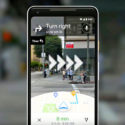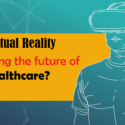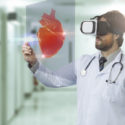Augmented Reality (AR) has the potential to transform aviation/aerospace industry by creating new mixed reality worlds that serve as a medium for gaining work-related skills.
Augmented Reality for Aircraft Maintenance
- Aviation maintenance facilities for general, commercial, and governmental organizations operate, inspect, and maintain complex aircraft structures and systems with many highly interrelated components.
- An AR system has the potential to enable job task training and job task guidance for the novice technician in a real-world environment.
- An AR system could reduce the cost for training and retraining of AMTs by complementing human information processing and assisting with performance of job tasks.
- An AR system could eliminate the need to leave the aircraft for the retrieval of information from maintenance manuals for inspection and repair procedures.
Virtual Reality for Airport Security and Safety Training
- Traditional collaborative training is both resource intensive and time-consuming.
- With a busy airport, it’s not feasible to practice where the actual disaster response would take place.
- In using a virtual facsimile of any Airport, trainees can practice their emergency procedures on a real facility.
- The logistical and response challenges present in the real environment translates to the virtual giving trainees a chance to perform as they would in real life.
Augmented Reality for Aircraft Windshields
Augmented Reality services enhance the pilots’ ability to visualize terrain, navigation, traffic, weather, and airspace along with convenience and safety items like an emergency, preflight, in-flight, and landing checklists (without the need for pilots to take their eyes off the sky, and access multiple screens and devices).
E.g. When the pilot looks up from the instrument panel, runway overlay information seamlessly appears.
Virtual Reality In-Flight Training Simulator
With virtual reality techniques, flight simulation industry provides a cost-effective way of training pilots, either military or civilian.
These flight simulators are used for training pilots in developing new skills in handling aircraft under unusual operating conditions and discovering the flight characteristics of a new aircraft.
Virtual Reality in space systems infrastructure and operations
- Application of virtual reality (VR) technology offers much promise to enhance and accelerate the development of space systems infrastructure and operations while simultaneously reducing developmental and operational costs.
- From control center design analyses to extravehicular activity (EVA) operations development to mission and science training for crew and ground controllers, VR can provide cost-effective methods to prepare for and conduct space flight operations.
- Publically available launch video with simulated data using VR can be used to demonstrate mission operations.
- VR can address all aspects of space exploration like planning space missions, practicing them, experiencing them from afar and even enduring the trip there and the long stay on alien territory etc. e.g. In May 2016, NASA announced the development of the virtual-reality systems to train astronauts, maneuver the Mars rover and support explorers on their long journey to Mars.
Virtual Reality for Aerospace and Aeronautics Build and Service
Virtual Engineering lets you get actively engaged with your Virtual Prototype in a truly realistic way from the very earliest stages of design to safeguard the engineering process for optimally designed products.
- Speed-up product maturity and decrease rework costs by earliest possible proof of feasibility and operability
- Massive rework cost reduction by enabling early error identification and efficient decision making
Virtual Build helps to achieve a higher product maturity by validating a significant number of assembly sequences well long before physical mock-ups are available.
- Compliance of ergonomic relevant installation guidelines
- Higher throughput/shorter cycle time due to improved Tooling access review/ validation/ training
Virtual Service helps to generate tangible savings on warranty and maintenance costs by Virtual Validation of assembly and disassembly procedures at the earliest stage.
- Validate maintenance feasibility and costs already during early development stages
- 3D lifelike experience will add a new dimension of technical communication – establishing improved workflows and better understanding
Using Microsoft HoloLens for training on aircraft engine parts
- Currently, flight crew trainees studying for promotion use mainly panels that display photos of cockpit instruments and switches to learn operational procedures in the early stages of their training.
- Using HoloLens, they will have a detailed hologram in front of their eyes that will display cockpit devices and switches that they can operate themselves, with visual and voice guidance provided through HoloLens.
- Mechanics can learn an engine structure by extracting important parts with the simulation,” learning names of parts and studying the structure of engines and surrounding systems, regardless of location or time of day.






21 thoughts on “How AR/VR/MR can transform the Aerospace Industry?”
Wow, that’s what I was seeking for, what a data! present here
at this weblog, thanks admin of this web site.
Thanks for your valuable feedback.
Simply want to say your article is as astounding.
Thank you!
Hi all, here every one is sharing these kinds of knowledge,
thus it’s pleasant to read this web site, and I used to pay a visit this webpage all the
time.
I’m not that much of a online reader to be honest but your sites really nice, keep
it up! I’ll go ahead and bookmark your website to come back in the future.
Thank you for your interest and support
Hi there, You’ve done a fantastic job. I will certainly digg it and personally recommend to
my friends. I’m sure they’ll be benefited from this website.
Thanks for commenting
I am regular visitor, how are you everybody? This piece of writing posted
at this web site is really nice.
Pretty section of content. I just stumbled upon your web site and in accession capital to assert
that I get in fact enjoyed account your blog posts.
Any way I will be subscribing to your feeds and even I achievement you
access consistently rapidly.
Thanks for your visit and response!
Good info. Lucky me I reach on your website by accident, I bookmarked it.
Thanks for positive feedback.
bookmarked!!, I love your site!
Thanks very interesting blog!
When some one searches for his vital thing, so he/she
desires to be available that in detail, therefore that thing is maintained over here.
Thank you for your valuable feedback!
I like the valuable info you provide in your articles.
I’ll bookmark your weblog and check again here regularly.
I’m quite certain I will learn many new stuff right here!
Good luck for the next!
Pretty! This has been an incredibly wonderful post.
Many thanks for supplying this info.
Excellent write-up. I definitely love this site. Keep it up!